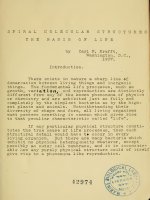- Trang chủ >>
- Khoa Học Tự Nhiên >>
- Vật lý
assembling the tree of life jul 2004
Bạn đang xem bản rút gọn của tài liệu. Xem và tải ngay bản đầy đủ của tài liệu tại đây (10.6 MB, 593 trang )
Assembling the Tree of Life
Joel Cracraft
Michael J. Donoghue,
Editors
OXFORD UNIVERSITY PRESS
Assembling the Tree of Life
This page intentionally left blank
Assembling the Tree of Life
EDITED BY Joel Cracraft
Michael J. Donoghue
1
2004
1
Oxford New York
Auckland Bangkok Buenos Aires Cape Town Chennai
Dar es Salaam Delhi Hong Kong Istanbul Karachi Kolkata
Kuala Lumpur Madrid Melbourne Mexico City Mumbai Nairobi
São Paulo Shanghai Taipei Tokyo Toronto
Copyright © 2004 by Oxford University Press, Inc.
Published by Oxford University Press, Inc.,
198 Madison Avenue, New York, New York 10016
www.oup.com
Oxford is a registered trademark of Oxford University Press
All rights reserved. No part of this publication may be reproduced,
stored in a retrieval system, or transmitted, in any form or by any means,
electronic, mechanical, photocopying, recording, or otherwise,
without the prior permission of Oxford University Press.
Library of Congress Cataloging-in-Publication Data
Assembling the tree of life / edited by Joel Cracraft, Michael J. Donoghue.
p. cm.
Proceedings of a symposium held at the American Museum of Natural History in New York, 2002.
Includes bibliographical references and index.
ISBN 0-19-517234-5
1. Biology—Classification—Congresses. I. Cracraft, Joel. II. Donoghue, Michael J.
QH83.A86 2004
578'.01'2—dc22 2003058012
987654321
Printed in the United States of America
on acid-free paper
Contents
Contributors ix
Introduction: Charting the Tree of Life 1
Michael J. Donoghue and Joel Cracraft
I The Importance of Knowing the Tree of Life
1 The Importance of the Tree of Life to Society 7
Terry L. Yates, Jorge Salazar-Bravo, and Jerry W. Dragoo
2 A Tangled Bank: Reflections on the Tree of Life and Human Health 18
Rita R. Colwell
3 The Fruit of the Tree of Life: Insights into Evolution and Ecology 25
Douglas J. Futuyma
II The Origin and Radiation of Life on Earth
4 The Tree of Life: An Overview 43
S. L. Baldauf, D. Bhattacharya, J. Cockrill, P. Hugenholtz, J. Pawlowski, and A. G. B. Simpson
5 The Early Branches in the Tree of Life 76
Norman R. Pace
6 Bacteria and Archaea 86
W. Ford Doolittle
7 The Origin and Radiation of Eucaryotes 95
Hervé Philippe
8 Viruses and the Tree of Life 107
David P. Mindell, Joshua S. Rest, and Luis P. Villarreal
III The Relationships of Green Plants
9 Algal Evolution and the Early Radiation of Green Plants 121
Charles F. Delwiche, Robert A. Andersen, Debashish Bhattacharya, Brent D. Mishler,
and Richard M. McCourt
10 The Radiation of Vascular Plants 138
Kathleen M. Pryer, Harald Schneider, and Susana Magallón
11 The Diversification of Flowering Plants 154
Pamela S. Soltis, Douglas E. Soltis, Mark W. Chase, Peter K. Endress, and Peter R. Crane
IV The Relationships of Fungi
12 The Fungi 171
John W. Taylor, Joseph Spatafora, Kerry O’Donnell, François Lutzoni, Timothy James,
David S. Hibbett, David Geiser, Thomas D. Bruns, and Meredith Blackwell
V The Relationships of Animals: Overview
13 The History of Animals 197
Douglas J. Eernisse and Kevin J. Peterson
14 Protostomes and Platyhelminthes: The Worm’s Turn 209
D. Timothy J. Littlewood, Maximilian J. Telford, and Rodney A. Bray
VI The Relationships of Animals: Lophotrochozoans
15 Toward a Tree of Life for Annelida 237
Mark E. Siddall, Elizabeth Borda, and Gregory W. Rouse
16 The Mollusca: Relationships and Patterns from Their First Half-Billion Years 252
David R. Lindberg, Winston F. Ponder, and Gerhard Haszprunar
VII The Relationships of Animals: Ecdysozoans
17 Arthropod Systematics: The Comparative Study of Genomic, Anatomical, and
Paleontological Information 281
Ward C. Wheeler, Gonzalo Giribet, and Gregory D. Edgecombe
18 Arachnida 296
Jonathan A. Coddington, Gonzalo Giribet, Mark S. Harvey, Lorenzo Prendini, and David E. Walter
19 Are the Crustaceans Monophyletic? 319
Frederick R. Schram and Stefan Koenemann
20 Phylogenetic Relationships and Evolution of Insects 330
Rainer Willmann
21 Phylogeny of the Holometabolous Insects: The Most Successful Group
of Terrestrial Organisms 345
Michael F. Whiting
VIII The Relationships of Animals: Deuterostomes
22 From Bilateral Symmetry to Pentaradiality: The Phylogeny of Hemichordates
and Echinoderms 365
Andrew B. Smith, Kevin J. Peterson, Gregory Wray, and D. T. J. Littlewood
23 Chordate Phylogeny and Development 384
Timothy Rowe
vi Contents
24 Gnathostome Fishes 410
M. L. J. Stiassny, E. O. Wiley, G. D. Johnson, and M. R. de Carvalho
25 Amphibians: Leading a Life of Slime 430
David Cannatella and David M. Hillis
26 Resolving Reptile Relationships: Molecular and Morphological Markers 451
Michael S. Y. Lee, Tod W. Reeder, Joseph B. Slowinski, and Robin Lawson
27 Phylogenetic Relationships among Modern Birds (Neornithes): Toward an Avian
Tree of Life 468
Joel Cracraft, F. Keith Barker, Michael Braun, John Harshman, Gareth J. Dyke, Julie Feinstein,
Scott Stanley, Alice Cibois, Peter Schikler, Pamela Beresford, Jaime García-Moreno,
Michael D. Sorenson, Tamaki Yuri, and David P. Mindell
28 Building the Mammalian Sector of the Tree of Life: Combining Different Data
and a Discussion of Divergence Times for Placental Mammals 490
Maureen A. O’Leary, Marc Allard, Michael J. Novacek, Jin Meng, and John Gatesy
29 Human Origins: Life at the Top of the Tree 517
Bernard Wood and Paul Constantino
IX Perspectives on the Tree of Life
30 The Meaning of Biodiversity and the Tree of Life 539
Edward O. Wilson
31 A Tree Grows in Manhattan 543
David B. Wake
32 The Tree of Life and the Grand Synthesis of Biology 545
David M. Hillis
33 Immeasurable Progress on the Tree of Life 548
Michael J. Donoghue
34 Assembling the Tree of Life: Where We Stand at the Beginning
of the 21st Century 553
Joel Cracraft and Michael J. Donoghue
Index 563
Contents vii
This page intentionally left blank
Marc Allard
Department of Biological Science
The George Washington University
Washington, DC 20052
Robert A. Andersen
Bigelow Laboratory for Ocean
Sciences
W. Boothbay Harbor, ME 04575
S. L. Baldauf
Department of Biology
University of York
P.O. Box 373
York YO10 5YW
England, UK
F. Keith Barker
James Ford Bell Museum of Natural
History
University of Minnesota
1987 Upper Buford Circle
St. Paul, MN 55108
Pamela Beresford
Percy FitPatrick Institute
University of Cape Town
Rondebosch 7701
Republic of South Africa
Debashish Bhattacharya
Department of Biological Sciences
University of Iowa
Iowa City, IA 52242–1324
Meredith Blackwell
Department of Biological Sciences
Louisiana State University
Baton Rouge, LA 70803
Elizabeth Borda
Division of Invertebrate Zoology
American Museum of Natural History
Central Park West at 79th Street
New York, NY 10024
Michael Braun
Laboratory of Analytical Biology
Department of Systematic Biology
Smithsonian Institution
4210 Silver Hill Road
Suitland, MD 20746
Rodney A. Bray
Parasitic Worms Division
Department of Zoology
The Natural History Museum
Cromwell Road
London SW7 5BD
England, UK
Contributors
Thomas D. Bruns
Plant and Microbial Biology
University of California
Berkeley, CA 94720
David Cannatella
Department of Integrative Biology
University of Texas
Austin, TX 78712
M. R. de Carvalho
Departamento de Biologia–FFCLRP
Universidade de São Paulo
Ribeirão Preto
Brazil
Mark W. Chase
Jodrell Laboratory
Royal Botanic Gardens
Kew, Richmond
Surrey TW9 3DS
England, UK
Alice Cibois
Department of Mammalogy and
Ornithology
Natural History Museum of Geneva
CP 6434
1211 Geneva 6
Switzerland
ix
J. Cockrill
Department of Biology
University of York
P.O. Box 373
York YO10 5YW
England, UK
Jonathan A. Coddington
Department of Systematic Biology
National Museum of Natural History
Smithsonian Institution
Washington, DC 20560
Rita R. Colwell
Director
National Science Foundation
Arlington, VA 22230
Paul Constantino
Department of Anthropology
The George Washington University
2110 G Street NW
Washington, DC 20052
Joel Cracraft
Department of Ornithology
American Museum of Natural History
Central Park West at 79th Street
New York, NY 10024
Peter R. Crane
Royal Botanic Gardens
Kew, Richmond
Surrey TW9 3AB
England, UK
Charles F. Delwiche
Department of Cell Biology and
Molecular Genetics
University of Maryland College Park
College Park, MD 20742-5815
Michael J. Donoghue
Department of Ecology and Evolution-
ary Biology
Yale University
New Haven, CT 06520
W. Ford Doolittle
Canadian Institute for Advanced
Research
Department of Biochemistry and
Molecular Biology
Dalhousie University
Halifax, Nova Scotia
Canada B3H 4H7
Jerry W. Dragoo
Department of Biology and
Museum of Southwestern Biology
University of New Mexico
Albuquerque, NM 87131
Gareth J. Dyke
Department of Zoology
University College Dublin
Belfield, Dublin 4
Ireland
Gregory D. Edgecombe
Australian Museum
6 College Street
Sydney, New South Wales 2010
Australia
Douglas J. Eernisse
Department of Biological Science
California State University
Fullerton, CA 92834
Peter K. Endress
Institute of Systematic Botany
University of Zurich
Zurich
Switzerland
Julie Feinstein
Department of Ornithology
American Museum of Natural History
Central Park West at 79th Street
New York, NY 10024
Douglas J. Futuyma
Department of Ecology and
Evolutionary Biology
University of Michigan
Ann Arbor, MI 48109-1079
Jaime García-Moreno
Max Planck Research Centre for
Ornithology and University of
Konstanz
Schlossalleé 2
D-78315 Radolfzell
Germany
John Gatesy
Department of Biology
University of California-Riverside
Riverside, CA 92521
David Geiser
Plant Pathology
Pennsylvania State University
University Park, PA 16804
Gonzalo Giribet
Department of Organismic and
Evolutionary Biology, and Museum
of Comparative Zoology
Harvard University
16 Divinity Avenue
Cambridge, MA 02138
John Harshman
4869 Pepperwood Way
San Jose, CA 95124
Mark S. Harvey
Department of Terrestrial Inverte-
brates
Western Australian Museum
Francis Street
Perth, Western Australia 6000
Australia
Gerhard Haszprunar
Zoologischen Staatssammlung
München
Münchhausenstrasse 27
81247 Munich
Germany
David S. Hibbett
Department of Biology
Clark University
Worcester, MA 01610
David M. Hillis
Section of Integrative Biology and
Center for Computational Biology
and Bioinformatics
University of Texas
Austin, TX 78712
P. Hugenholtz
ComBinE Group
Advanced Computational Modelling
Centre
The University of Queensland
Brisbane 4072
Australia
Timothy James
Department of Biology
Duke University
Durham, NC 27708
x Contributors
G. D. Johnson
Division of Fishes
National Museum of Natural History
Washington, DC 20560
Stefan Koenemann
Institute for Biodiversity and Ecosys-
tem Dynamics
University of Amsterdam
Mauritskade 61
1092 AD Amsterdam
The Netherlands
Robin Lawson
Department of Herpetology
California Academy of Sciences
Golden Gate Park
San Francisco, CA 94118-4599
Michael S. Y. Lee
Department of Environmental Biology,
University of Adelaide
Department of Palaeontology, South
Australian Museum
Adelaide, SA 5000
Australia
David R. Lindberg
Museum of Paleontology
1101 Valley Life Science Building
University of California
Berkeley, CA 94720-4780
D. Timothy J. Littlewood
Parasitic Worms Division
Department of Zoology
The Natural History Museum
Cromwell Road
London SW7 5BD
England, UK
François Lutzoni
Department of Biology
Duke University
Durham, NC 27708
Susana Magallón
Departemento de Botánica, Instituto
de Biología
Universidad Nacional Autónoma de
México
Circuito Exterior, Anexo al Jardín
Botánico
AP 70–233
México DF 04510
Richard M. McCourt
Department of Botany
Academy of Natural Sciences
Philadelphia, PA 19103
Jin Meng
Division of Paleontology
American Museum of Natural History
79th Street at Central Park West
New York, NY 10024-5192
David P. Mindell
Department of Ecology and Evolution-
ary Biology and Museum of
Zoology
University of Michigan
Ann Arbor, MI 48109-1079
Brent D. Mishler
Department of Integrative Biology
University of California Berkeley
Berkeley, CA 94720
Michael J. Novacek
Division of Paleontology
American Museum of Natural History
79th Street at Central Park West
New York, NY 10024-5192
Kerry O’Donnell
National Center for Agricultural
Utilization Research
Agriculture Research Service
1815 N. University Street
Peoria, IL 61604
Maureen A. O’Leary
Department of Anatomical Sciences
HSC T-8 (040)
Stony Brook University
Stony Brook, NY 11794-8081
Norman R. Pace
Department of Molecular, Cellular
and Developmental Biology
Campus Box 0347
University of Colorado
Boulder, CO 80309-0347
J. Pawlowski
Department of Zoology and Animal
Biology
University of Geneva
1224 Chêne-Bougeries/Geneva
Switzerland
Kevin J. Peterson
Department of Biological Sciences
Dartmouth College
Hanover, NH 03755
Hervé Philippe
Département de Biochimie
Université de Montréal
Pavillon principal—Bureau F-315
C. P. 6128 Succursale Centre-Ville
Montréal, Quebec
Canada H3C 3J7
Winston F. Ponder
Division of Invertebrate Zoology
Australian Museum
Sydney, NSW 2010
Australia
Lorenzo Prendini
Division Invertebrate Zoology
American Museum of Natural History
Central Park West at 79th Street
New York, NY 10024
Kathleen M. Pryer
Department of Biology
Duke University
Durham, NC 27708
Tod W. Reeder
Department of Biology
San Diego State University
San Diego, CA 92182-4614
Joshua S. Rest
Department of Ecology and
Evolutionary Biology and Museum
of Zoology
University of Michigan
Ann Arbor, MI 48109-1079
Gregory W. Rouse
South Australian Museum
Adelaide, SA 5000
Australia
Timothy Rowe
Jackson School of Geosciences, C1100
The University of Texas at Austin
Austin, TX 78712
Contributors xi
Jorge Salazar-Bravo
Department of Biology and Museum
of Southwestern Biology
University of New Mexico
Albuquerque, NM 87131
Peter Schikler
Department of Ornithology
American Museum of Natural History
Central Park West at 79th Street
New York, NY 10024
Harald Schneider
Albrecht-von-Haller-Institut für
Pflanzenwissenschaften
Abteilung Systematische Botanik
Georg-August-Universität Göttingen
Untere Karspüle 2
37073 Göttingen
Germany
Frederick R. Schram
Institute for Biodiversity and
Ecosystem Dynamics
University of Amsterdam
Mauritskade 61
1092 AD Amsterdam
The Netherlands
Mark E. Siddall
Division of Invertebrate Zoology
American Museum of Natural History
Central Park West at 79th Street
New York, NY 10024
A. G. B. Simpson
Canadian Institute for Advanced
Research
Department of Biochemistry and
Molecular Biology
Dalhousie University
Halifax, Nova Scotia
Canada B3H 4H7
Joseph B. Slowinski (deceased)
Department of Herpetology
California Academy of Sciences
Golden Gate Park
San Francisco, CA 94118-4599
Andrew B. Smith
Department of Palaeontology
The Natural History Museum
Cromwell Road
London SW7 5BD
England, UK
Douglas E. Soltis
Department of Botany
University of Florida
Gainesville, FL 32611
Pamela S. Soltis
Florida Museum of Natural History
University of Florida
Gainesville, FL 32611
Michael D. Sorenson
Department of Biology
Boston University
5 Cummington Street
Boston, MA 02215
Joseph Spatafora
Botany and Plant Pathology
Oregon State University
Corvallis, OR 97331
Scott Stanley
411 Cary Pines Drive
Cary, NC 27513
M. L. J. Stiassny
Department of Ichthyology
American Museum of Natural History
Central Park West at 79th Street
New York, NY 10024
John W. Taylor
Department of Plant and Microbial
Biology
University of California
Berkeley, CA 94720-3102
Maximilian J. Telford
University Museum of Zoology
Department of Zoology
Cambridge University
Downing Street
Cambridge CB2 3EJ
England, UK
Luis P. Villarreal
Department of Molecular Biology and
Biochemistry, and Center for Virus
Research
University of California at Irvine
Irvine, CA 92697
David B. Wake
Museum of Vertebrate Zoology and
Department of Integrative Biology
University of California
Berkeley, CA 94720-3160
David E. Walter
Department of Biological Sciences
University of Alberta
Edmonton, AB
Canada T6G 2E9
Ward C. Wheeler
Division of Invertebrate Zoology
American Museum of Natural History
Central Park West at 79th Street
New York, NY 10024-5192
Michael F. Whiting
Department of Integrative Biology
Brigham Young University
Provo, UT 84042
E. O. Wiley
Ecology and Evolutionary Biology
University of Kansas
Lawrence, KS 66045
Rainer Willmann
Zoologisches Institut der Universität
Georg-August-Universität Göttingen
Berliner Strasse 28
D-37073 Göttingen
Germany
Edward O. Wilson
Department of Organismic and
Evolutionary Biology and the
Museum of Comparative Zoology
Harvard University
16 Divinity Avenue
Cambridge, MA 02138
Bernard Wood
Department of Anthropology
The George Washington University
2110 G Street NW
Washington, DC 20052
xii Contributors
Gregory Wray
Department of Biology
Duke University
Durham, NC 27708
Terry L. Yates
Department of Biology and Museum
of Southwestern Biology
University of New Mexico
Albuquerque, NM 87131
Tamaki Yuri
Laboratory of Analytical Biology
Department of Systematic Biology
Smithsonian Institution
4210 Silver Hill Road
Suitland, MD 20746
Contributors xiii
This page intentionally left blank
Assembling the Tree of Life
This page intentionally left blank
1
Introduction
Charting the Tree of Life
Michael J. Donoghue
Joel Cracraft
Many, perhaps even most, people today are comfortable with
the image of a tree as a representation of how species are
related to one another. The Tree of Life has become, we think,
one of the central images associated with life and with sci-
ence in general, alongside the complementary metaphor of
the ecological Web of Life. But this was not always the case.
Before Darwin, the reigning view was perhaps that life was
organized like a ladder or “chain of being,” with slimy “primi-
tive” creatures at the bottom and people (what else!) at the
very top. Darwin (1859) solidified in our minds the radically
new image of a tree (fig. I.1), within which humans are but
one of many (as we now know, millions) of other species
situated at the tips of the branches. The tree, it turns out, is
the natural image to convey ancestry and the splitting of lin-
eages through time, and therefore is the natural framework
for “telling” the genealogical history of life on Earth.
Very soon after Darwin, interest in piecing together the
entire Tree of Life began to flourish. Ernest Haeckel’s (1866)
trees beautifully symbolize this very active period and also,
through their artistry, highlight the comparison between real
botanical trees and branching diagrams representing phylo-
genetic relationships (fig. I.2).
However, during this period, and indeed until the 1930s,
rather little attention was paid to the logic of inferring how
species (or the major branches of the Tree of Life) are related
to one another. In part, the lack of a rigorous methodology
(especially compared with the newly developing fields of
genetics and experimental embryology) was responsible for
a noticeable lull in activity in this area during the first sev-
eral decades of the 1900s. But, beginning in the 1930s, with
such pioneers as the German botanist Walter Zimmermann
(1931), we begin to see the emergence of the basic concepts
that underlie current phylogenetic research. For example, the
central notion of “phylogenetic relationship” was clearly de-
fined in terms of recency of common ancestry—we say that
two species are more closely related to one another than either
is to a third species if and only if they share a more recent
common ancestor (fig. I.3).
This period in the development of phylogenetic theory
culminated in the foundational work of the German ento-
mologist Willi Hennig. Many of his central ideas were put
forward in German in the 1950s (Hennig 1950), but world-
wide attention was drawn to his work after the publication
of Phylogenetic Systematics in English (Hennig 1966). Hennig
emphasized, among many other things, the desirability of
recognizing only monophyletic groups (or clades—single
branches of the Tree of Life) in classification systems, and
the idea that shared derived characteristics (what he called
synapomorphies) provided critical evidence for the existence
of clades (fig. I.4).
Around this same time, in other circles, algorithms were
being developed to try to compute the relatedness of spe-
cies. Soon, a variety of computational methods were imple-
mented and were applied to real data sets. Invariably, given
the tools available in those early days, these were what would
now be viewed as extremely small problems.
1
2 Introduction
Figure I.1.
The only illustration in Darwin’s Origin of Species (1859), which can be taken to be
the beginning of “tree thinking.”
Since that time major developments have occurred along
several lines. First, although morphological characters were
at first the sole source of evidence for phylogenetic analyses,
molecular data, especially DNA sequences, have become
available at an exponential rate. Today, many phylogenetic
analyses are carried out using molecular data alone. How-
ever, morphological evidence is crucial in many cases, but
especially when the object is to include extinct species pre-
served as fossils. Ultimately, of course, there are advantages
in analyzing all of the evidence deemed relevant to a particular
phylogenetic problem—morphological and molecular. And
many of our most robust conclusions about phylogeny, high-
lighted in this volume, are based on a combination of data
from a variety of sources.
A second major development has been increasing compu-
tational power, and the ease with which we can now manipu-
late and analyze extremely large phylogenetic data sets. Initially,
such analyses were extremely cumbersome and time-consum-
ing. Today, we can deal effectively and simultaneously with
vast quantities of data from thousands of species.
Beginning in the 1990s these developments all came to-
gether—the image and meaning of a tree, the underlying
conceptual and methodological developments, the ability to
assemble massive quantities of data, and the ability to quan-
titatively evaluate alternative phylogenetic hypotheses using
a variety of optimality criteria. Not surprisingly, the number
of published phylogenetic analysis skyrocketed (Hillis, ch.
32 in this vol.). Although it is difficult to make an accurate
assessment, in recent years phylogenetic studies have been
published at a rate of nearly 15 a day.
Where has this monumental increase in activity really
gotten us in terms of understanding the Tree of Life? That
was the question that motivated the symposium that we or-
ganized in 2002 at the American Museum of Natural His-
tory in New York, and which yielded the book you have in
front of you. Although it may be apparent that there has been
a lot of activity, and that a lot can now be written about the
phylogeny of all the major lineages of life, it is difficult to
convey a sense of just how rapidly these findings have been
accumulating. Previously, there was a similar attempt to pro-
vide a summary statement across all of life—a Nobel sym-
posium in Sweden in 1988, which culminated in a book titled
The Hierarchy of Life (Fernholm et al. 1989). That was an
exciting time, and the enthusiasm and potential of this en-
Introduction 3
deavor were expressed in the chapters of that book. But, in
looking back at those pages we are struck by the paucity of
data and the minuscule size of the analyses that were being
performed at what was surely the cutting edge of research at
the time.
It is also clear that so much more of the Tree of Life is
being explored today than only a decade ago. Now we can
honestly present a picture of the relationships among all of
the major branches of the Tree of Life, and within at least
some of these major branches we are now able to provide
considerable detail. A decade ago the holes in our knowledge
were ridiculously obvious—we were really just getting started
on the project. There are giant holes today, which will be-
come increasingly obvious in the years to come (as we learn
more about species diversity, and database phylogenetic
knowledge), but we believe that it is now realistic to conceive
of reconstructing the entire Tree of Life—eventually to in-
clude all of the living and extinct species. A decade ago, we
could hardly conjure up such a dream. Today we not only
can imagine what the results will look like, but we now be-
lieve it is attainable.
It also has become increasingly obvious to us just how
important it is to understand the structure of the Tree of
Life in detail. With the availability of better and better esti-
mates of phylogeny, awareness has rapidly grown outside
of systematic biology that phylogenetic knowledge is es-
sential for understanding the history of character change
and for interpreting comparative data of all sorts within a
historical context. At the same time, phylogeny and the
algorithms used to build trees have taken on increasing
importance within applied biology, especially in managing
our natural resources and in improving our own health
and well-being. Phylogenetic trees now commonly appear
in journals that had not previously devoted much space
to trees or to “tree thinking,” and many new tools have
been developed to leverage this new information on
relationships.
Figure I.2. A phylogenetic tree realized by Haeckel (1866),
soon after Darwin’s Origin.
Figure I.3. Zimmermann’s (1931) tree, illustrating the concept
of “phylogenetic relationship.”
Figure I.4. The conceptual phylogenetic argumentation scheme
of Hennig (1966: 91), with solid boxes representing derived
(apomorphic) and open boxes representing primitive
(plesiomorphic) characters.
4 Introduction
In this volume we have tried, with the chapters in the
opening and closing sections, to highlight the value of the Tree
of Life, and then, in a series of chapters by leading experts, to
summarize the current state of affairs in many of its major
branches. In presenting this information, we appreciate that
many important groups are not covered in sufficient detail, and
a few not at all, and we know that in some areas information
will already be outdated. This is simply the nature of the
progress we are making—new clades are discovered literally
every day—and the sign of a healthy discipline. Nevertheless,
our sense is that a benchmark of our progress early in the 21st
century is a worthy exercise, especially if it can help motivate
the vision and mobilize the resources to carry out the mega-
science project that the Tree of Life presents. This would surely
be one of the most fundamental of all scientific accomplish-
ments, with benefits that are abundantly evident already and
surprises whose impacts we can hardly imagine.
Acknowledgments
The rapidly expanding activity in phylogenetics noted above set
the stage for a consideration and critical evaluation of our
current understanding of the Tree of Life. This juncture in
time also coincided with the inception of the International
Biodiversity Observation Year (IBOY; available at http://
www.nrel.colostate.edu/projects/iboy) by the international
biodiversity science program DIVERSITAS (http://www.
diversitas-international.org) and its partners. Assembling the
Tree of Life (ATOL) was accepted as a key project of IBOY, and
a symposium and publication were planned. This volume is the
outgrowth of that process.
The ATOL symposium would not have been possible
without the participation of many institutions and individuals.
Key, of course, was the financial commitment received from the
host institutions, the American Museum of Natural History
(AMNH) and Yale University, and from the International Union
of Biological Sciences (IUBS), a lead partner of DIVERSITAS and
convenor of Systematics Agenda 2000 International. Assembling
the Tree of Life (ATOL) was accepted as a core project of the
DIVERSITAS program, International Biodiversity Observation
Year (IBOY). We especially acknowledge the leadership of Ellen
Futter (president) and Michael Novacek (senior vice president
and provost) of the AMNH and of Alison Richard (provost) of
Yale University for making the symposium possible. In addition,
a financial contribution from IUBS facilitated international
attendance, and we are grateful to Marvalee Wake (president),
Talal Younes (executive director), and Diana Wall (director,
IBOY) for their support.
The scientific program of the symposium was planned with
the critical input of Michael Novacek and many other col-
leagues, and we are grateful for their suggestions. Ultimately, we
tried to cover as much of the Tree of Life as possible in three
days and at the same time to include plenary speakers whose
charge was to summarize the importance of phylogenetic
knowledge for science and society. We are well aware of the
omissions and imbalances that result from an effort such as this
one and which are manifest in this volume. Our ultimate goal
was to produce a single volume that would broadly cover the
Tree of Life and that would be useful to the systematics
community as well as accessible to a much wider audience. We
challenged the speakers to involve as many of their colleagues as
possible and to summarize what we know, and what we don’t
know, about the phylogeny of each group, and to write their
chapters for a scientifically literate general audience, but not at
the expense of scientific accuracy. We trust that their efforts will
catalyze future research and greatly enhance communication
about the Tree of Life.
The symposium itself could not have been undertaken
without the tireless effort of numerous people. The staff of the
AMNH and its outside symposium coordinator, DBK Events,
spent countless hours over many months facilitating arrange-
ments with the speakers and attendees, and not least, making
the organizers’ lives much easier. It is not possible to identify all
of those who contributed, but we would be remiss if we did not
mention the following: Senior Vice President Gary Zarr, and
especially Ann Walle, Anne Canty, Robin Lloyd, Amy Chiu, and
Rose Ann Fiorenzo of the AMNH Department of Communica-
tions; Joanna Dales of Events and Conference Services; Mike
Benedetto of IT-Network Systems; Frank Rasor and Larry Van
Praag of the Audio-Visual Department; and Jennifer Kunin of
DBK Events.
Finally, many colleagues helped with production of this
volume. Many referees, both inside and outside of our institu-
tions, contributed their time to improve the chapters. Merle
Okada and Christine Blake, AMNH Department of Ornithology,
helped in many ways with editorial tasks, and Susan Donoghue
assisted with the index. Most important, we are grateful to Kirk
Jensen of Oxford University Press for believing in the project
and facilitating its publication, and to Peter Prescott for seeing it
through.
Literature Cited
Darwin, C. R. 1859. On the origin of species. John Murray,
London.
Fernholm, B., K. Bremer, and H. Jörnvall (eds.). 1989. The
hierarchy of life. Nobel Symposium 70. Elsevier, Amsterdam.
Haeckel, E. 1866. Generelle Morphologie der Organismen:
allgemeine Grundzüge der organischen Formen-Wissenschaft,
mechanisch begründet durch die von Charles Darwin
reformirte Descendenz-Theorie. G. Reimer, Berlin.
Hennig, W. 1950. Grundzüge einer Theorie des phylogenetischen
Systematik. Deutscher Zentraverlag, Berlin.
Hennig, W. 1966. Phylogenetic systematics. University of
Illinois Press, Urbana.
Zimmermann, W. 1931. Arbeitsweise der botanischen
Phylogenetik und anderer Gruppierubgswissenschaften.
Pp. 941–1053 in Hanbuch der biologischen
Arbeitsmethoden (E. Abderhalden, ed.), Abt. 3, 2, Teil 9.
Urban & Schwarzenberg, Berlin.
I
The Importance of Knowing the Tree of Life
This page intentionally left blank
1
The Importance of the Tree of Life to Society
The affinities of all the beings of the same class have
sometimes been represented by a great tree. . . . As buds give
rise by growth to fresh buds, and these, if vigorous, branch
out and overtop on all sides many a feebler branch, so by
generation I believe it has been with the great Tree of Life,
which fills with its dead and broken branches the crust of the
earth, and covers the surface with its ever branching and
beautiful ramifications.
—Charles Darwin, On the Origin of Species (1859)
Terry L. Yates
Jorge Salazar-Bravo
Jerry W. Dragoo
Despite Darwin’s vision of the existence of a universal Tree
of Life, assembly of the tree with a high degree of accuracy
has proven challenging to say the least. Generations of sys-
tematists have worked on the problem and debated (or
fought) about how to best approach a solution, or questioned
if a solution was even possible. Much of the rest of the bio-
logical sciences and medicine either simply accepted deci-
sions of systematists without question or discounted them
entirely as lacking rigor and accuracy. Attempts at solving
the problem met with only limited success and were gener-
ally limited to similarity comparisons of various kinds until
the convergence of three important developments: (1) con-
ceptual and methodological underpinnings of phylogenetic
systematics, (2) development of genomics, and (3) rapid
advances in information technology.
Convergence of these three areas makes construction of
a robust tree representing genealogical relationships of all
known species possible for the first time. This, coupled with
the fact that the current lack of a universal tree is severely
hampering progress in many areas of science and limiting the
ability of society to address many important problems and
to capitalize on a host of opportunities, demands that we
undertake this important project now and with conviction.
Although many challenges still stand before us (which them-
selves represent additional opportunities), constructing a
complete Tree of Life is now conceptually and technologi-
cally possible for the first time. It is relevant to note here that
we still had hundreds of problems to solve when we decided
to land a man on the moon, and their solution produced
hundreds of unexpected by-products. The size of this un-
dertaking and the human resources needed, however, require
an international collaboration instead of a competition. As-
sembling an accurate universal tree depicting relationships
of all life on Earth, from microbes to mammals, holds enor-
mous potential value for society, and it is imperative that we
start now. This chapter, although not meant to be exhaus-
tive, aims to provide a number of examples where even our
limited knowledge of the tree has provided tangible benefits
to society. The actual value that a fully assembled tree would
hold for society would be limitless.
Enabling Technologies and Challenges
Despite widespread acceptance of phylogenetic systematics
during the 1980s, it was not until the advent of genomics
and modern computer technology, enabled by more efficient
and rapid phylogenetic algorithms in the 1990s, that large-
scale tree assembly became possible. The rapid growth of
genomics, in particular, revolutionized the field of phyloge-
netic systematics and provided a new level of power to tree
assembly. To reconstruct the evolutionary history of all or-
ganisms will require continued advances in computer hard-
ware and development of faster and more efficient algorithms.
The mathematics and computer science communities are
already actively engaged in this challenge, and breakthroughs
7
8 The Importance of Knowing the Tree of Life
are occurring almost daily. For example, researchers work-
ing on resolving the relationships of 12 species of bluebells
back to a common ancestor have used the 105 genes found
in chloroplast DNA from those species (and an outgroup
—tobacco) to reconstruct the phylogeny. The resulting analy-
sis examined 14 billion trees. But not only did they recon-
struct the phylogeny, they also inferred the gene order of the
105 genes found in the chloroplast genome for each ances-
tor in the tree, which means 100 billion “genomes” were
analyzed. The process took 1 hour and 40 minutes using a
512-processor supercomputer (Moret et al. 2002).
Although this represents a major advancement, addi-
tional advancements will be needed for the relationships of
the current 1.7 million known species to be reconstructed.
Necessary software tools have not been developed to take full
advantage of existing data and to permit integration with
existing biological databases. The enormous amounts of data
being generated by the enabling technologies associated with
modern genomics, although posing considerable challenges
to the computer world, will allow tree construction at a level
of detail far exceeding anything in the past.
Even in groups such as mammals that are well known rela-
tive to invertebrates and microbes, the use of genomics in tree
construction is increasing our knowledge base at a phenom-
enal rate and providing important bridges to other fields of
knowledge. Recent work by Dragoo and Honeycutt (1997),
for example, has revealed that skunks represent a lineage of
their own distinct from mustelids (fig. 1.1). Skunks histori-
cally have been classified as a subfamily within the Mustelidae
(weasels), but genetic data suggest that raccoons are more
closely related to weasels than are skunks. Additionally, stink
badgers were classified within a different subfamily of muste-
lids than skunks. Morphological and genetic data both sup-
port inclusion of stink badgers within the skunk clade. The
skunk–weasel–raccoon relationship was based on analyses of
genes within the mitochondrial genome. However, DNA se-
quencing of nuclear genes has provided support for this hy-
pothesis as well (Flynn et al. 2000, and K. Koepfli, unpubl.
obs.). This discovery is already proving valuable to other fields
such as public health and conservation.
These types of advances are producing major discover-
ies across the entire tree, but nowhere is it more evident than
in the microbial world. New discoveries using genomics and
phylogenetic analysis have led to the discovery of entire new
groups of Archaea (DeLong 1992) that will prove critical to
our understanding of the functioning of the world’s ecosys-
tems. Others using similar techniques are discovering major
groups of important microbes living in extreme environments
(Fuhrman et al. 1992) that could lead to discovery of impor-
tant new classes of compounds. In fact, the number of new
species of bacteria being discovered with these methods, as
noted by DeLong and Pace (2001), is expanding almost ex-
ponentially. It is not only new species that are being discov-
ered but also new kingdoms of organisms within the domains
Bacteria and Archaea.
Human Health
Ten people died in April through June 1993 as a result of an
unknown disease that emerged in the desert Southwest of
the United States. Approximately 70% of the people who ac-
Figure 1.1. Phylogenetic
relationship of skunks with
relation to weasels as well as
other caniform carnivores;
modified from Dragoo and
Honeycutt (1997). The arrow
indicates a sister-group
relationship between weasels
(Mustelidae) and raccoons
(Procyonidae) to the exclusion
of skunks. Skunks thus were
recognized as a distinct family,
Mephitidae.
Mephitidae
Mustelidae
Procyonidae
Pinnipedia
Ursidae
Canidae
Feliformia
Hog
-
nosed Skunk
Striped Skunk
Spotted Skunk
Stink Badger
Small- clawed Otter
River Otter
Sea Otter
Zorilla
Mink
Long - tailed Weasel
Ferret
Wolverine
Marten
European Badger
American Badger
Ringtail
Raccoon
Kinkajou
Walrus
Sea Lion
Seal
Bear
Coyote
Gray Fox
Ocelot
Mongoose









